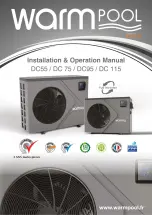
# 48387H005
Page 15
Charge Using Superheat Method (Fixed Orifice Systems)
– Outdoor Temperatures 65°F or above
1. With the manifold gauge hose on the suction service
port and the unit operating stably, use a digital ther-
mometer to record the suction line temperature.
2. At the same time, record the suction line pressure
reading.
3. Use the temperature/pressure chart (Table 6) to
determine the saturation temperature for the suction
line pressure reading.
4. Subtract the saturation temperature (according to the
chart) from the suction line temperature to determine
the superheat.
5. Compare the superheat value with those shown in
Table 8. If superheat is greater than shown, add some
refrigerant. If superheat is less than shown, recover
some refrigerant.
Charge Using Approach Method (TXV Systems)
– Outdoor Temperatures 65°F or Above
The following procedure is intended as a general guide
and is for use on expansion valve systems only. For best
results, indoor temperature should 70°F to 80°F. Monitor
system pressures while charging.
1. Record outdoor ambient temperature using a digital
thermometer.
2. Attach high pressure gauge set and operate unit for
several minutes to allow system pressures to stabilize.
3. Compare stabilized pressures with those provided in
Table 9 on page 16. Minor variations in these pres-
sures may be expected due to differences in installa-
tions.
Significant differences could mean that the
system is not properly charged or that a problem
exists with some component in the system.
Pressures higher than those listed indicate that the
system is overcharged. Pressures lower than those
listed indicate that the system is undercharged. Verify
adjusted charge using the approach method.
4. Use the same digital thermometer to check liquid line
temperature.
5. Subtract the outdoor ambient temperature from the
liquid line temperature to determine the approach
temperature.
5. Compare the subcooling value with those shown in
Table 7. If subcooling is greater than shown, recover
some refrigerant. If subcooling is less than shown,
add some refrigerant.
_____ °
Saturation Temperature °F
_____ °
Liquid Line Temperature °F
_____ °
Subcooling Value °F
–
=
_____ °
Suction Line Temperature °F
_____ °
Saturation Temperature °F
_____ °
Superheat Value °F
–
=
r
o
o
d
t
u
O
.
p
m
e
T
F
°
)
F
°
1
±
(
g
n
i
l
o
o
c
b
u
S
d
i
u
q
i
L
8
1
-
4
2
-
0
3
-
6
3
-
2
4
-
8
4
-
0
6
-
5
6
0
1
4
1
0
1
0
1
3
1
5
1
1
1
5
7
7
2
1
8
7
1
1
3
1
0
1
5
8
6
1
1
6
6
0
1
1
1
9
5
9
4
9
4
4
8
9
8
5
0
1
3
6
3
3
7
8
7
5
1
1
2
5
2
2
5
6
6
Subcooling Values for
Fixed Orifice or TXV Systems
Table 7
.
p
m
e
T
t
n
e
i
b
m
A
r
o
o
d
t
u
O
F
°
t
a
e
h
r
e
p
u
S
F
°
0
6
8
3
5
6
5
3
0
7
0
3
5
7
6
2
0
8
2
2
5
8
8
1
0
9
2
1
5
9
8
0
0
1
5
5
0
1
0
Superheat Values for
Fixed Orifice Systems
(80°F DB/67°F WB Return Air)
Table 8






































